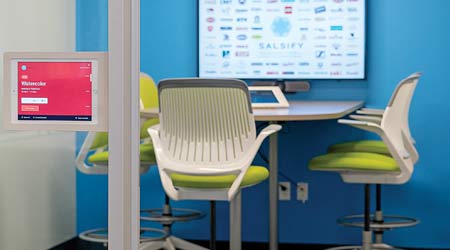 At Salsify, a green screen on the door indicates that a meeting room is available; red means the room is occupied. The conference room scheduling system provides data on room use that will allow facility managers to reconfigure the spaces to match occupant demand.Warren Patterson Photography
At Salsify, a green screen on the door indicates that a meeting room is available; red means the room is occupied. The conference room scheduling system provides data on room use that will allow facility managers to reconfigure the spaces to match occupant demand.Warren Patterson PhotographyNew Technology Accommodates Changing Workplace Needs
New, exciting technology in three areas — real estate transactions, property ownership, and tenant/workplace occupancy — is creating a paradigm shift in workplace design and operations.
Commercial real estate has been managed more or less the same way for decades: An office building is constructed; a tenant/user occupies it; the occupant moves if more or less space is required or the lease has expired. New technologies offer opportunities to fundamentally change that paradigm. The new paradigm goes well beyond real estate. For example, we used to watch whatever channels were offered on television. Now we can select from a wide variety of entertainment sources and features (stream content, record programs, fast-forward through commercials, manage subscription costs, etc.). We interact with media and customize it to our liking, and we can do that now with the workplace too. This newfound technological interaction is disrupting every aspect of real estate finance, facility management, and tenant use.
There are three primary categories of disruptive real estate and facility management technologies:
• Real estate transactions
• Property ownership
• Tenant/workplace occupancy
Each technology category provides distinct benefits that facilitate better interaction and more efficient management. Yet the ultimate market driver of them all is tenant/workplace occupancy, because it is tenant users that create demand for real estate in the marketplace. A better understanding for the implications of these disruptive technologies can help building owners and facility managers design, build, and manage more responsive and cost-effective buildings.
Changing workplace
According to a recent survey by Herman Miller, 40 percent of workstations are occupied less than half the time, and private offices are on average occupied only 25 percent of the time. Building owners and facility managers are coming to realize what an enormous waste of resources this represents – one that feels increasingly jarring as we move toward a more shared economy. As we become more acculturated to businesses like Uber, Airbnb, Hubway, Getaround, and WeWork, among others, people are becoming more comfortable with the idea of sharing the workspace too. Many companies are shifting their workplace from fully assigned seating to “free address” space allocation for “activity-based work.” For employees who are not devoted to one focused task all day long, the free address concept allows them to choose where they want or need to sit based on their daily or hourly task, who they need to collaborate with, or what other adjacencies are important to their productivity.
In a seminar at Cornell University earlier this year, Christian Bigsby, senior vice president of worldwide real estate and facilities at GSK (GlaxoSmithKline), described how the company made this shift in workplace design. He said that “85 percent of the [office] footprint was dedicated to 35 percent of the work activities. We studied it in time and motion studies, and it is a classic misallocation of resources in a company. You cannot have one third of your activities supported by 85 percent of your resources. It's a complete squandering of resources.” GSK changed its model to increase the variety of work settings. There are now seven different options, from a telephone booth to a 16-person conference room, to a simple adjustable, four-foot long ergonomic desk for answering emails or making a quick call. “Offering a variety of work settings shrunk our footprint by almost half in the office settings, and it changed how people used the space,” Bigsby said. “Our data shows that 95 percent of employees that use those spaces would never go back to the way they were.”
Managing such a dynamic office environment — one that must be highly flexible and responsive — is only possible through a software support platform that is both simple to use and portable, and those technology systems now exist.
Related Topics:














